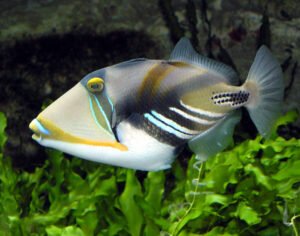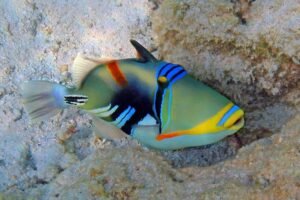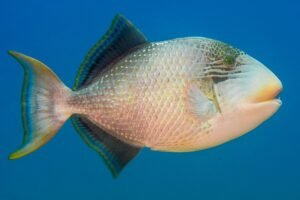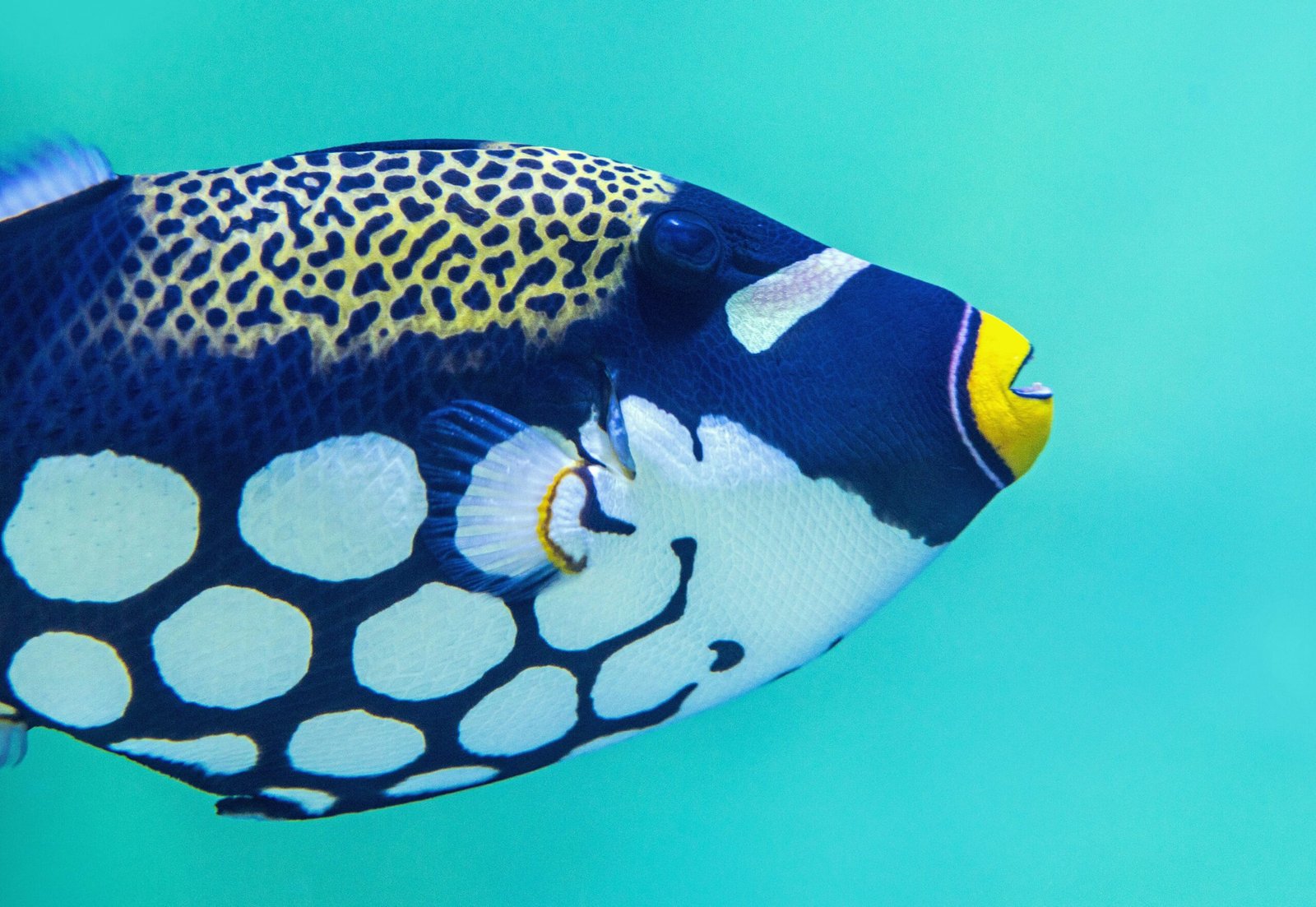Fascinating World of Triggerfish
In this blog post, we will explore the fascinating world of triggerfish. We will discuss where they live, their feeding habits, lifespan, and breeding habits. Triggerfish are known for their unique appearance and interesting behaviors, making them a popular subject of study and admiration among marine enthusiasts. Let’s dive in!
Triggerfish belong to the family Balistidae, which is comprised of around 40 species. These species are predominantly found in the tropical and subtropical waters of the Atlantic, Indian, and Pacific Oceans. They inhabit coral reefs, rocky coastlines, and seagrass beds, where they can find ample food and shelter.
When it comes to feeding habits, triggerfish are opportunistic carnivores. They have a varied diet that includes small fish, crustaceans, mollusks, and even sea urchins. Their strong jaws and sharp teeth allow them to crush the hard shells of their prey. Some species of triggerfish are also known to use their powerful jaws to crack open shells by picking up rocks and dropping them on their prey.
The lifespan of triggerfish varies depending on the species and environmental conditions. On average, they can live up to 10-12 years, although some individuals have been known to live longer in captivity. Factors such as predation, disease, and habitat degradation can affect their lifespan.
Breeding habits of triggerfish are quite interesting. They are generally monogamous, forming pairs that remain together for extended periods. During the breeding season, males construct nests on the sandy bottom or in crevices using their mouths to move and arrange the substrate. The female then lays her eggs in the nest, and the male fertilizes them. The male takes on the responsibility of guarding the nest until the eggs hatch, fanning them with his fins to provide oxygen and protect them from predators.
In conclusion, triggerfish are captivating creatures that inhabit the world’s oceans. Their unique appearance, feeding habits, lifespan, and breeding behaviors make them a fascinating subject of study. By delving into their world, we can gain a deeper understanding of the intricate relationships that exist within marine ecosystems. So, let’s continue our exploration and uncover more about these intriguing fish!
Habitat and Distribution
Triggerfish can be found in various tropical and subtropical oceans around the world. They have a wide distribution, inhabiting coral reefs, rocky shores, and seagrass beds. Some species of triggerfish are also found in estuaries and mangrove forests. These fish prefer warm waters and are commonly found in the Indian Ocean, Pacific Ocean, and the Atlantic Ocean.
Triggerfish are known for their ability to adapt to different environments within their preferred habitats. They have a remarkable capacity to thrive in both shallow and deep waters, allowing them to explore a variety of ecosystems. In coral reefs, triggerfish can be found darting in and out of the intricate crevices and caverns formed by the reef structures. Their vibrant colors and unique patterns make them a beautiful sight among the coral formations.

Rocky shores provide triggerfish with a different type of habitat. Here, they navigate through the intertidal zones, where the crashing waves meet the rugged coastline. The rocky terrain offers plenty of hiding spots and crevices for triggerfish to seek shelter and protection from predators. They are well adapted to the constant battering of the waves and can withstand the strong currents that are characteristic of these areas.
Seagrass beds are another favored habitat for triggerfish. These underwater meadows of seagrass provide them with ample food sources and shelter. Triggerfish can often be seen gliding gracefully through the swaying seagrass blades, using their specialized teeth to feed on small invertebrates and crustaceans that take refuge in the seagrass.
In addition to these habitats, triggerfish also venture into estuaries and mangrove forests. Estuaries, where freshwater and saltwater mix, offer a unique environment that triggersfish are able to adapt to. The brackish water of estuaries provides them with a diverse array of food sources, including small fish, mollusks, and insects. Mangrove forests, with their intricate root systems, offer triggerfish a sanctuary where they can hide and breed.
The wide distribution of triggerfish across the world’s oceans is a testament to their adaptability and resilience. From the vibrant coral reefs of the Indo-Pacific to the rocky shores of the Atlantic, these fish have established themselves as key players in their respective ecosystems. Their ability to thrive in a range of habitats makes them an important indicator species for the health and diversity of marine environments. As we continue to study and appreciate triggerfish, we gain a deeper understanding of the intricate web of life that exists beneath the surface of our oceans.
Feeding Habits
Triggerfish have a diverse diet that primarily consists of small invertebrates such as crustaceans, mollusks, and sea urchins. They also feed on algae and other marine plants. One of the unique feeding behaviors of triggerfish is their ability to use their strong jaws and teeth to crush hard-shelled prey. They will often pick up a shell or rock and repeatedly smash it against the coral or rocky substrate to access the tasty morsels inside.
Triggerfish are known to be territorial and will defend their feeding grounds from other fish. They are not afraid to use their sharp teeth and strong jaws to intimidate intruders. Some species of triggerfish have even been observed spitting water at potential threats to deter them.
It’s important to note that while triggerfish have a varied diet, they should not be fed a diet exclusively consisting of meat. They also require a balanced diet that includes plant matter to maintain their overall health and well-being.
In addition to their unique feeding habits, triggerfish also exhibit interesting hunting techniques. They have been observed using their specialized jaws to pry open the shells of mollusks and crustaceans. This allows them to access the soft flesh inside, which serves as a valuable source of nutrients.
Furthermore, triggerfish are known to be opportunistic feeders, taking advantage of any available food source in their environment. This adaptability allows them to survive in various habitats, from coral reefs to rocky coastlines. They have been observed scavenging for food, consuming the leftovers of larger predators or feeding on organic debris that accumulates on the ocean floor.
Another fascinating aspect of triggerfish feeding habits is their ability to manipulate their prey. Some species have been observed using their strong jaws to pick up rocks or pieces of coral and move them to expose hidden prey. This behavior demonstrates their intelligence and problem-solving skills when it comes to obtaining a meal.
Overall, the feeding habits of triggerfish showcase their versatility and resourcefulness in finding food. Whether it’s crushing shells, defending their territory, or using their jaws to manipulate their prey, triggerfish have developed unique strategies to ensure their survival in the diverse marine ecosystems they inhabit.
Lifespan
The lifespan of triggerfish varies depending on the species and environmental factors. On average, triggerfish can live for 5 to 10 years in the wild. However, some species have been known to live for up to 20 years under optimal conditions.
Their lifespan can be influenced by factors such as habitat quality, availability of food, predation, and human activities. Pollution, overfishing, and habitat destruction can significantly impact the lifespan of triggerfish and other marine species.
Triggerfish are incredibly adaptable creatures, capable of thriving in a wide range of habitats. They can be found in tropical and subtropical waters around the world, including the Atlantic, Pacific, and Indian Oceans. Some species even inhabit brackish estuaries and mangrove forests.
Triggerfish have a unique set of physical characteristics that allow them to survive in diverse environments. Their powerful jaws and sharp teeth enable them to crush and eat hard-shelled prey such as crustaceans and mollusks. Their small size and streamlined bodies make them agile swimmers, allowing them to navigate through coral reefs and rocky crevices with ease.
Despite their adaptability, triggerfish face numerous challenges that can impact their lifespan. One of the main threats they encounter is pollution. Chemical contaminants, such as oil spills and heavy metals, can accumulate in their bodies over time, leading to various health issues and reduced lifespan.
Overfishing is another major concern for triggerfish populations. They are often targeted for their meat and attractive appearance, which has led to a decline in their numbers in some areas. When triggerfish populations are overexploited, it disrupts the delicate balance of marine ecosystems, affecting not only triggerfish but also other species that depend on them for food or shelter.
Habitat destruction is yet another significant factor that can impact the lifespan of triggerfish. Coral reefs, which are important habitats for triggerfish, are under threat from climate change, pollution, and destructive fishing practices. When coral reefs are damaged or destroyed, triggerfish lose their homes and sources of food, leading to a decline in their population and overall lifespan.
In conclusion, while triggerfish have the potential to live for several years, their lifespan is influenced by various factors. Protecting their habitats, reducing pollution, and implementing sustainable fishing practices are crucial for ensuring the long-term survival of triggerfish and other marine species.
Breeding Habits
Triggerfish have unique breeding habits that involve the construction and defense of nests. Male triggerfish are responsible for preparing and defending the nest, which is usually a depression in the sand or a crevice in the coral reef.
When a female triggerfish is ready to lay her eggs, she will approach the male’s nest. The male will then perform a courtship display to attract the female’s attention. Once the female is satisfied with the male’s display, she will deposit her eggs in the nest.
The male triggerfish takes on the role of guardian, diligently protecting the nest from predators and intruders. He will aggressively chase away any fish or creature that comes too close to the nest. The male triggerfish will continue to guard the nest until the eggs hatch, which usually takes a few days to a couple of weeks.
Once the eggs hatch, the juvenile triggerfish will enter the water and begin their journey in the vast ocean. They will face various challenges and predators during this phase of their life cycle, and only a small percentage will survive to adulthood.
The survival of the juvenile triggerfish depends on their ability to adapt and find food in their new environment. They are born with an instinct to forage for small invertebrates and algae, which they use to sustain themselves. However, they are also vulnerable to larger predators such as sharks, barracudas, and other predatory fish.
During this phase, the juvenile triggerfish will undergo significant physical changes. They will grow rapidly, developing their distinctive shape and coloration. The triggerfish’s ability to change color is an important adaptation that helps them blend in with their surroundings and avoid detection by predators.
As the juvenile triggerfish continue to grow, they will gradually shift their diet to include a wider range of prey. They will become more efficient hunters, using their sharp teeth and strong jaws to capture and consume larger prey items. This transition from a diet of small invertebrates to larger prey is essential for their growth and development.
As they mature, triggerfish will also start to establish their territories. They will defend their chosen area from other triggerfish and potential intruders. These territories often include specific features of the coral reef, such as crevices or caves, which provide shelter and protection.
Triggerfish are known for their aggressive behavior when defending their territories. They will use their sharp teeth and strong jaws to bite and intimidate intruders. This behavior is not limited to other fish but can also extend to divers or snorkelers who enter their territory.
Overall, the breeding habits of triggerfish are fascinating and intricate. From the construction and defense of nests to the development and survival of their offspring, triggerfish demonstrate remarkable adaptations and behaviors that contribute to their success in the marine ecosystem.
